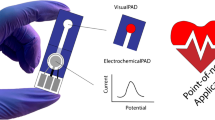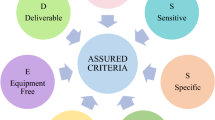Abstract
Paper-based microfluidics combined with printed electronics has the potential to yield exceptionally powerful point-of-care diagnostic devices at extremely low cost. To achieve such devices, new manufacturing methodologies must be developed to allow scalable, low-cost production whilst maintaining good reproducibility and performance. In this paper, we discuss the use of high-resolution inkjet printing of various advanced materials as a means to achieve the production of such devices. We present preliminary examples of printing techniques to produce both paper-based microfluidic devices and printed electronic components, which could be further developed into highly integrated, powerful, yet single-use, diagnostic devices. High-resolution inkjet printing of PDMS hydrophobic barriers on nitrocellulose membranes is demonstrated as a means to generate precise (~60-μm-wide) microfluidic circuits allowing low sample volume consumption. To our knowledge, these are the narrowest features produced in paper-based analytical devices via non-lithographic methods. In addition, a novel printing technique based upon agarose gel is demonstrated as a means to directly print microfluidic circuits in paper that may reduce fabrication time and costs as well allow deposition of agarose gel for electrophoresis applications. Printing methods are also used to deposit silver nanoparticle ink electrodes on nitrocellulose with good conductivity, and an all-printed, organic field-effect transistor on a silicon substrate is further presented. These examples serve to highlight the potential application of advanced printing techniques to the production of low-cost, highly functional diagnostic devices.














Similar content being viewed by others
References
Abe K, Suzuki K, Citterio D (2008) Inkjet-printed microfluidic multianalyte chemical sensing paper. Anal Chem 80:6928–6934
Abe K, Kotera K, Suzuki K, Citterio D (2010) Inkjet-printed paperfluidic immuno-chemical sensing device. Anal Bioanal Chem 398:885–893
Arora A, Simone G, Salieb-Beugelaar GB, Kim JT, Manz A (2010) Latest developments in micro total analysis systems. Anal Chem 82:4830–4847
Ballerini DR, Li X, Shen W (2012) Patterned paper and alternative materials as substrates for low-cost microfluidic diagnostics. Microfluid Nanofluid 13:769–787
Bergveld P (1981) The operation of an isfet as an electronic device. Sens Actuators 1:17–29
Bergveld P (2003) Thirty years of ISFETOLOGY—what happened in the past 30 years and what may happen in the next 30 years. Sens Actuators B-Chem 88:1–20
Bruzewicz DA, Reches M, Whitesides GM (2008) Low-cost printing of poly(dimethylsiloxane) barriers to define microchannels in paper. Anal Chem 80:3387–3392
Burroughes JH et al (1990) Light-emitting-diodes based on conjugated polymers. Nature 347:539–541
Carrilho E, Martinez AW, Whitesides GM (2009) Understanding wax printing: a simple micropatterning process for paper-based microfluidics. Anal Chem 81:7091–7095
Chin CD, Linder V, Sia SK (2012) Commercialization of microfluidic point-of-care diagnostic devices. Lab Chip 12:2118–2134
Dungchai W, Chailapakul O, Henry CS (2009) Electrochemical detection for paper-based microfluidics. Anal Chem 81:5821–5826
Esquivel JP, Del Campo FJ, de la Fuente JLG, Rojas S, Sabate N (2014) Microfluidic fuel cells on paper: meeting the power needs of next generation lateral flow devices. Energy Environ Sci 7:1744–1749
Fobel R, Kirby AE, Ng AHC, Farnood RR, Wheeler AR (2014) Paper microfluidics goes digital. Adv Mater 26:2838–2843
Focke M, Kosse D, Muller C, Reinecke H, Zengerle R, von Stetten F (2010) Lab-on-a-Foil: microfluidics on thin and flexible films. Lab Chip 10:1365–1386
Klauk H (ed) (2006) Organic electronics: materials, manufacturing, and applications. Wiley, Weinheim
Leng XF, Zhang WH, Wang CM, Cui LA, Yang CJ (2010) Agarose droplet microfluidics for highly parallel and efficient single molecule emulsion PCR. Lab Chip 10:2841–2843
Li X, Tian JF, Garnier G, Shen W (2010) Fabrication of paper-based microfluidic sensors by printing. Colloids Surf B Biointerfaces 76:564–570
Lu Y, Shi WW, Jiang L, Qin JH, Lin BC (2009) Rapid prototyping of paper-based microfluidics with wax for low-cost, portable bioassay. Electrophoresis 30:1497–1500
Lutz S et al (2010) Microfluidic lab-on-a-foil for nucleic acid analysis based on isothermal recombinase polymerase amplification (RPA). Lab Chip 10:887–893
Martinez AW, Phillips ST, Butte MJ, Whitesides GM (2007) Patterned paper as a platform for inexpensive, low-volume, portable bioassays. Angew Chem Int Ed 46:1318–1320
Martinez AW, Phillips ST, Carrilho E, Thomas SW, Sindi H, Whitesides GM (2008) Simple telemedicine for developing regions: camera phones and paper-based microfluidic devices for real-time, off-site diagnosis. Anal Chem 80:3699–3707
Martinez AW, Phillips ST, Whitesides GM, Carrilho E (2010) Diagnostics for the developing world: microfluidic paper-based analytical devices. Anal Chem 82:3–10
Nie ZH et al (2010) Electrochemical sensing in paper-based microfluidic devices. Lab Chip 10:477–483
Servati P, Nathan A, Amaratunga GAJ (2006) Generalized transport-band field-effect mobility in disordered organic and inorganic semiconductors. Phys Rev B 74
Steckl AJ (2013) Circuits on cellulose. IEEE Spectrum 50:48–81
Wong RC, Tse HY (eds) (2009) Lateral flow immunoassay. Humana Press, New York
Wu YF, Xue P, Hui KM, Rang YJ (2014) A paper-based microfluidic electrochemical immunodevice integrated with amplification-by-polymerization for the ultrasensitive multiplexed detection of cancer biomarkers. Biosens Bioelectron 52:180–187
Yetisen AK, Akram MS, Lowe CR (2013) Paper-based microfluidic point-of-care diagnostic devices. Lab Chip 13:2210–2251
Zhang HF, Jenkins G, Zou Y, Zhu Z, Yang CJ (2012) Massively parallel single-molecule and single-cell emulsion reverse transcription polymerase chain reaction using agarose droplet microfluidics. Anal Chem 84:3599–3606
Acknowledgments
This work was supported by the Nanjing University of Posts and Telecommunications talent start-up fund NY212009.
Author information
Authors and Affiliations
Corresponding authors
Additional information
Yang Wang and Ye Lei Xie have contributed equally to this work.
Rights and permissions
About this article
Cite this article
Jenkins, G., Wang, Y., Xie, Y.L. et al. Printed electronics integrated with paper-based microfluidics: new methodologies for next-generation health care. Microfluid Nanofluid 19, 251–261 (2015). https://doi.org/10.1007/s10404-014-1496-6
Received:
Accepted:
Published:
Issue Date:
DOI: https://doi.org/10.1007/s10404-014-1496-6




